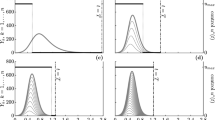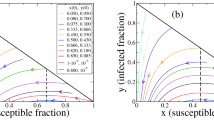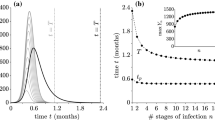Abstract
The aim of this article is to understand how to apply partial or total containment to SIR epidemic model during a given finite time interval in order to minimize the epidemic final size, that is the cumulative number of cases infected during the complete course of an epidemic. The existence and uniqueness of an optimal strategy are proved for this infinite-horizon problem, and a full characterization of the solution is provided. The best policy consists in applying the maximal allowed social distancing effort until the end of the interval, starting at a date that is not always the closest date and may be found by a simple algorithm. Both theoretical results and numerical simulations demonstrate that it leads to a significant decrease in the epidemic final size. We show that in any case the optimal intervention has to begin before the number of susceptible cases has crossed the herd immunity level, and that its limit is always smaller than this threshold. This problem is also shown to be equivalent to the minimum containment time necessary to stop at a given distance after this threshold value.







Similar content being viewed by others
Notes
In other words, they only take a.e. two different values.
Other valuable contributions are to be found in [26], including the consideration of added integral term accounting for control cost, and hospital overflow minimization.
To avoid any misunderstanding about the differentiability of \(S(\cdot )\) with respect to \(T_0\), let us make the use of \(\widehat{S}\) precise. This function stands for the derivative of the function \([0,T]\ni T_0\mapsto S(\cdot ,T_0)\in C^0 ([T_0,T])\), where \(S(\cdot ,T_0)\) is defined as the unique solution to (20b) on \([T_0,T]\), where \(S(T_0)\) is defined as the value at \(T_0\) of the unique solution to (20a). Defined in this way, the differentiability of this mapping is standard.
More precisely, we call “admissible direction” any element of the tangent cone \(\mathcal {T}_{u,{\mathcal {U}}_{\alpha , T}}\) to the set \({\mathcal {U}}_{\alpha , T}\) at u. The cone \(\mathcal {T}_{u,{\mathcal {U}}_{\alpha , T}}\) is the set of functions \(h\in L^\infty (0,T)\) such that, for any sequence of positive real numbers \(\varepsilon _n\) decreasing to 0, there exists a sequence of functions \(h_n\in L^\infty (0,T)\) converging to h as \(n\rightarrow +\infty \), and \(u+\varepsilon _nh_n\in {\mathcal {U}}_{\alpha , T}\) for every \(n\in {\mathbb {N}}\).
References
Abakuks, A.: An optimal isolation policy for an epidemic. J. Appl. Probab. 10(2), 247–262 (1973)
Abakuks, A.: Optimal immunisation policies for epidemics. Adv. Appl. Probab. 6(3), 494–511 (1974)
Ainseba, B., Iannelli, M.: Optimal screening in structured SIR epidemics. Math. Modell. Nat. Phenom. 7(3), 12–27 (2012)
Alkama, M., Elhia, M., Rachik, Z., Rachik, M., Labriji, E.H.: Free terminal time optimal control problem of an SIR epidemic model with vaccination. Int. J. Sci. Res. 3, 227 (2014)
Greenhalgh, D.: Some results on optimal control applied to epidemics. Math. Biosci. 88(2), 125–158 (1988)
Andreasen, V.: The final size of an epidemic and its relation to the basic reproduction number. Bull. Math. Biol. 73(10), 2305–2321 (2011)
Gaff, H., Schaefer, E.: Optimal control applied to vaccination and treatment strategies for various epidemiological models. Math. Biosci. Eng. 6(3), 469 (2009)
Behncke, H.: Optimal control of deterministic epidemics. Optim. Control Appl. Methods 21(6), 269–285 (2000)
Bliman, P.A., Duprez, M.: How best can finite-time social distancing reduce epidemic final size? J. Theor. Biol. 511, 110557 (2020)
Bolzoni, L., Bonacini, E., Soresina, C., Groppi, M.: Time-optimal control strategies in SIR epidemic models. Math. Biosci. 292, 86–96 (2017)
Bolzoni, L., Bonacini, E., Marca, R.D., Groppi, M.: Optimal control of epidemic size and duration with limited resources. Math. Biosci. 315, 108232 (2019)
Buonomo, B., Manfredi, P., d’Onofrio, A.: Optimal time-profiles of public health intervention to shape voluntary vaccination for childhood diseases. J. Math. Biol. 78(4), 1089–1113 (2019)
Buonomo, B., Della Marca, R., d’Onofrio, A.: Optimal public health intervention in a behavioural vaccination model: the interplay between seasonality, behaviour and latency period. Math. Med. Biol. A J. IMA 36(3), 297–324 (2019)
Di Blasio, G.: A synthesis problem for the optimal control of epidemics. Numer. Funct. Anal. Optim. 2(5), 347–359 (1980)
Shim, E.: Optimal dengue vaccination strategies of seropositive individuals. Math. Biosci. Eng. 16(3), 1171–1189 (2019)
Gaff, H., Schaefer, E.: Optimal control applied to vaccination and treatment strategies for various epidemiological models. Math. Biosci. Eng. 6(3), 469 (2009)
Greenhalgh, D.: Some results on optimal control applied to epidemics. Math. Biosci. 88(2), 125–158 (1988)
Hansen, E., Day, T.: Optimal control of epidemics with limited resources. J. Math. Biol. 62(3), 423–451 (2011)
Hollingsworth, T.D., Klinkenberg, D., Heesterbeek, H., Anderson, R.M.: Mitigation strategies for pandemic influenza A: balancing conflicting policy objectives. PLoS Comput. Biol. 7(2), e1001076 (2011)
Hu, Q., Zou, X.: Optimal vaccination strategies for an influenza epidemic model. J. Biol. Syst. 21(04), 1340006 (2013)
Morris, D.H., Rossine, F.W., Plotkin, J.B., Levin, S.A.: Optimal, near-optimal, and robust epidemic control. arXiv preprint arXiv:2004.02209 (2020)
Jaberi-Douraki, M., Moghadas, S.M.: Optimality of a time-dependent treatment profile during an epidemic. J. Biol. Dyn. 7(1), 133–147 (2013)
Jaberi-Douraki, M., Heffernan, J.M., Wu, J., Moghadas, S.M.: Optimal treatment profile during an influenza epidemic. Differ. Equ. Dyn. Syst. 21(3), 237–252 (2013)
Katriel, G.: The size of epidemics in populations with heterogeneous susceptibility. J. Math. Biol. 65(2), 237–262 (2012)
Kermack, W.O., McKendrick, A.G.: Contributions to the mathematical theory of epidemics-I. Proc. R. Soc. 115A, 700–721 (1927)
Jaberi-Douraki, M., Moghadas, S.M.: Optimality of a time-dependent treatment profile during an epidemic. J. Biol. Dyn. 7(1), 133–147 (2013)
Jaberi-Douraki, M., Heffernan, J.M., Wu, J., Moghadas, S.M.: Optimal treatment profile during an influenza epidemic. Differ. Equ. Dyn. Syst. 21(3), 237–252 (2013)
Kolesin, I.D., Zhitkova, E.M.: Optimization of immunocorrection of collective immunity. Autom. Remote Control 77(6), 1031–1040 (2016)
Kolesin, I.D., Zhitkova, E.M.: Optimization of immunocorrection of collective immunity. Autom. Remote Control 77(6), 1031–1040 (2016)
Laguzet, L., Turinici, G.: Globally optimal vaccination policies in the SIR model: smoothness of the value function and uniqueness of the optimal strategies. Math. Biosci. 263, 180–197 (2015)
Lee, E.B., Markus, L.: Foundations of Optimal Control Theory. Wiley, New York (1967)
Ma, J., Earn, D.J.: Generality of the final size formula for an epidemic of a newly invading infectious disease. Bull. Math. Biol. 68(3), 679–702 (2006)
Manfredi, P., D’Onofrio, A.: Modeling the Interplay Between Human Behavior and the Spread of Infectious Diseases. Springer, Berlin (2013)
Angulo, M.T., Castaños, F., Velasco-Hernandez, J.X., Moreno, J.A.: A simple criterion to design optimal nonpharmaceutical interventions for epidemic outbreaks. medRxiv (2020)
Miller, J.C.: A note on the derivation of epidemic final sizes. Bull. Math. Biol. 74(9), 2125–2141 (2012)
Kermack, W.O., McKendrick, A.G.: Contributions to the mathematical theory of epidemics-I. Proc. R. Soc. 115A, 700–721 (1927)
Morton, R., Wickwire, K.H.: On the optimal control of a deterministic epidemic. Adv. Appl. Probab. 6(4), 622–635 (1974)
Piguillem, F., Shi, L.: The optimal COVID-19 quarantine and testing policies. Tech. Rep, Einaudi Institute for Economics and Finance (EIEF) (2020)
Salje, H., Kiem, C.T., Lefrancq, N., Courtejoie, N., Bosetti, P., Paireau, J., Andronico, A., Hozé, N., Richet, J., Dubost, C.L., et al.: Estimating the burden of SARS-CoV-2 in France. Science (2020)
Shim, E.: Optimal dengue vaccination strategies of seropositive individuals. Math. Biosci. Eng. 16(3), 1171–1189 (2019)
Wickwire, K.H.: Optimal isolation policies for deterministic and stochastic epidemics. Math. Biosci. 26(3–4), 325–346 (1975)
Wickwire, K.: Optimal immunization rules for an epidemic with recovery. J. Optim. Theory Appl. 27(4), 549–570 (1979)
Yang, K., Wang, E., Zhou, Y., Zhou, K.: Optimal vaccination policy and cost analysis for epidemic control in resource-limited settings. Kybernetes (2015)
Zhou, Y., Wu, J., Wu, M.: Optimal isolation strategies of emerging infectious diseases with limited resources. Math. Biosci. Eng. MBE 10, 1691–1701 (2013)
Acknowledgements
The authors express their sincere acknowledgment to working groups Maths4Covid19 and OptimCovid19 for fruitful discussions and in particular their colleagues Luis Almeida (CNRS UMR 7598, LJLL, France), Emmanuel Franck (INRIA Grand-Est and IRMA Strasbourg, France), Sidi-Mahmoud Kaber (Sorbonne Université, LJLL, France), Grégoire Nadin (CNRS UMR 7598, LJLL, France) and Benoît Perthame (Sorbonne Université, LJLL, France).
Author information
Authors and Affiliations
Corresponding author
Additional information
Communicated by Irena Lasiecka.
Publisher's Note
Springer Nature remains neutral with regard to jurisdictional claims in published maps and institutional affiliations.
Appendix A-Implementation Issues
Appendix A-Implementation Issues
We provide here an insight of the numerical methods used in Sect. 3. The codes are available on:
https://github.com/michelduprez/optimal-immunity-control.git.
1.1 A.1. Solving Problem \(\mathcal {P}_{\alpha ,T}\) by a Direct Approach
In order to check the consistency of the results of Theorem 2.3, we solved directly the optimal control problem \(\mathcal {P}_{\alpha ,T}\). Our approach rests upon the use of gradient like algorithms, which necessitates the computation of the differential of \(S_\infty \) in an admissible directionFootnote 4h. According to the proof of Theorem 2.2 (see Sect. 4.3), this differential reads
where \((p_S,p_I)\) denotes the adjoint state, solving the backward adjoint system (14a)–(14b). Thanks to this expression of \(DS_\infty (u)\cdot h\), we deduce a simple projected gradient algorithm to solve numerically the optimal control problem \(\mathcal {P}_{\alpha ,T}^{\varPhi }\), then \(\mathcal {P}_{\alpha ,T}\). The algorithm is described in Algorithm 1. The projection operator \(\mathbb {P}_{\mathcal {U}_{\alpha ,T}}\) is given by

1.2 A.2. Solving Problem \(\mathcal {P}_{\alpha ,T}\) Thanks to the Theoretical Results
Taking advantage of the theoretical results given in Theorem 2.3, we then considered a simpler algorithm, based on the solution of Problem \(\widetilde{\mathcal {P}}_{\alpha ,T}\) by bisection method. This method is described in Algorithm 2.

All computations shown in Sect. 3 indicate, as expected, that the optimal trajectories computed by the two methods do coincide.
For illustrative purpose, we provide in Fig. 8 the graph of the cost \(j(T_0)\) defined in (18) that corresponds to the one-dimensional optimization Problem \(\widetilde{\mathcal {P}}_{\alpha ,T}\). As can be seen, the cost is not convex.
Rights and permissions
About this article
Cite this article
Bliman, PA., Duprez, M., Privat, Y. et al. Optimal Immunity Control and Final Size Minimization by Social Distancing for the SIR Epidemic Model. J Optim Theory Appl 189, 408–436 (2021). https://doi.org/10.1007/s10957-021-01830-1
Received:
Accepted:
Published:
Issue Date:
DOI: https://doi.org/10.1007/s10957-021-01830-1





